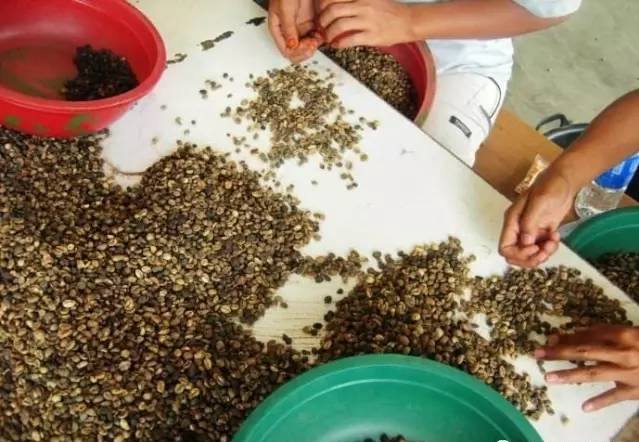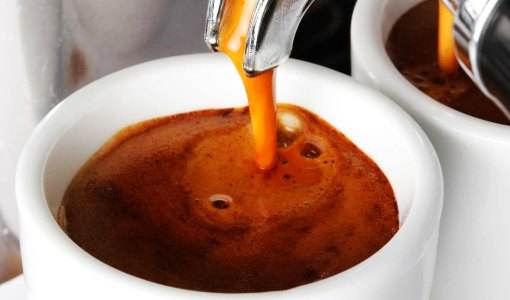Coffee treatment, wet planing
Mention "Indonesia" and you immediately associate it with the "tough guy" of coffee circles-mantnin, which is characterized by low acidity, high body, and a slight herbal and woody flavor.
Soil and water environment is an important factor affecting it, but more important is Indonesia's unique traditional coffee treatment method: wet planing method.
Before we go into more detail about "wet planing," let's review the structure of coffee.
germ
endosperm
silver skin
parchment
colloidal layer
pulp
skin

1 Wet planing
Indonesian Giling Basah, Giling translated as "smooth, grind", Basah translated as "wet", translated as "wet body peeling treatment", which is what we call "wet peeling".
In other areas, the process of drying coffee takes about 2 weeks, and only the peel and pectin are removed during the process; however, Indonesia has a humidity of more than 50% throughout the year, and typhoons are frequent in some areas and rainfall exceeds 2000 mm per year.
Coffee farmers have adapted to local conditions and created a unique wet planing method in humid climates: removing parchment and silver skin in advance, shortening the drying process to 3-4 days, accelerating the entire drying process, and effectively reducing the impact of climate on coffee.
Step 1: Screening
As with other treatments, the first step involves screening. The coffee cherries are picked and placed in a pool. The ripe fruits settle to the bottom of the pool, while the immature fruits float to the surface. The coffee farmers need to select the immature fruits first.
Step 2: Peel
The ripe red fruit is now peeled in a peeling machine. The wet peeling method uses a smaller peeling machine that puts the shelled beans into a vat or tank of water to remove the defective shelled beans floating on the liquid surface.
Step 3: Dry fermentation
Take out the dense shelled beans that have sunk to the bottom and leave them overnight in a bucket or plastic bag for dry fermentation. The longer the fermentation time, the stronger the sour taste, usually for several hours, depending on the person; this also helps to decompose the pectin component in the gelatinous pulp, which makes it easier for the pulp to be removed in the next washing step.
Step 4: Wet planing and drying
With shell beans exposure for one to two days, the moisture content of the bean body up to 30%-50%, the bean body is still semi-hard and semi-soft, with the shell machine to wipe off the seed shell and then sun, that is, we call "wet planing". Then drying, about two days, moisture content of 12%-13%.
flavor characteristics
Because parchment and silver skin were removed during the treatment, the beans were exposed to the outside world for drying, and the color of the beans by wet planing was blue-green.
The faster fermentation process also results in a lower acidity and higher body of wet-planed coffee, which also has a light earthy aroma that some describe as herbaceous.
Important Notice :
前街咖啡 FrontStreet Coffee has moved to new addredd:
FrontStreet Coffee Address: 315,Donghua East Road,GuangZhou
Tel:020 38364473
- Prev

Lift the mysterious veil of extraction and rich coffee
Since childhood, we have heard so much that I like full-bodied coffee, even we have said it ourselves. But what exactly do we mean by this, and is full-bodied coffee a completely different concept as baristas understand it? Now let's go into science (which I added myself), right? Don't worry, we'll tell you slowly. What is it?
- Next

Treatment of decaf coffee
Follow the caffeine review (Wechat official account vdailycom) found that the beautiful cafe opened a small shop of its own so-called decaffeinated coffee, as the name implies, there is only a small amount of caffeinated coffee. Coffee contains many ingredients and substances, among which caffeine has an obvious effect on the human body. For many people who are addicted to coffee but whose physical condition does not allow caffeine intake.
Related
- What is the meaning of lactic acid fermentation with coffee bean treatment?
- How to judge the state of foam by sound?
- How does the latte pull out the unicorn pattern? Come to get for a little trick to improve the flower pull!
- Will flower pulling affect the taste of the latte?
- Do you know the history of coffee?
- The difference between honey treatment and sun washing what is raisin honey treatment?
- What kind of milk can a novice use to make coffee foam to keep the foam longer? The correct method and skills of milking tutorial sharing
- Why do washed coffee beans taste sour? Flavor characteristics of washed Coffee
- Introduction to the skill of how to practice the size and height of water injection around the circle of hand-brewed coffee
- How do beginners practice coffee flower drawing from scratch?

